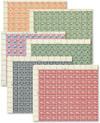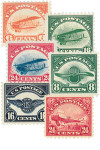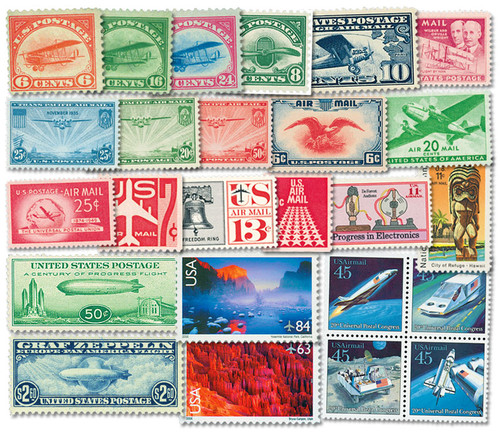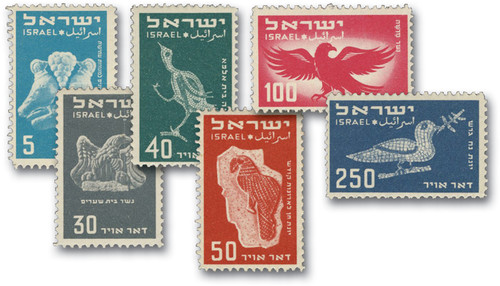
# C1-6 - 1918-23 First Airmail Stamps, set of 6
You Can Own the First Six U.S. Airmail Stamps
The first airmail stamps were issued in 1918. The U.S. Airmail Service was born that year, when two 90-horsepower Curtiss Jenny airplanes departed for Philadelphia from New York and Washington.
The Act of May 6, 1918, authorized the Post Office Department to carry the mail by airplane. This ruling necessitated a new stamp – one of distinctive design and color. A red frame and blue vignette (design) on white paper created a patriotic “red, white and blue” airmail issue (the 24¢ Curtiss Jenny – #C3). The airmail rate was set at 24¢ per ounce and thus the first airmail stamp was born!
In June of 1918, the airmail rate was reduced to 16¢ for up to the first ounce (this charge included a special delivery fee) and 6¢ for each additional ounce. This rate change produced a new stamp which reflected the same design as the original, but was done in only one color instead of three (16¢ Curtiss Jenny – #C2).
In the latter part of 1918, the airmail rate was again reduced. The fee was 6¢ per ounce (eliminating the additional 10¢ special delivery charge of the previous stamp). The original airmail design was used once again, but the single color was changed from green (on the 16¢ issue) to orange (6¢ Curtiss Jenny – #C1).
Strangely, in the early days of airmail service, mail dispatched by air took longer to reach its destination than mail sent by train. People stopped using airmail because it was less efficient and the rate was high. Often, mail was lost entirely, due to accidents. Postmaster General Irving Glover drew up plans for “night flights,” to prove that airmail service was a time-saving device. The U.S. (from New York to the Pacific Coast) was divided into several zones. Airmail delivery for a one-ounce letter, from one zone to the next, was 8¢. A new airmail stamp was needed, and the #C4 design was created.
The stamp picturing the Air Service Emblem (#C5) was issued to cover postage for an airmail letter of one ounce or less, for a distance covering two zones within the United States. The 24¢ DeHavilland Biplane, pictured on #C6, eventually replaced the Jenny in carrying the mail. This particular stamp was issued to provide payment for night flights from New York all the way to the Pacific Coast.
These stamps are important to building a complete airmail collection – order yours now.
You Can Own the First Six U.S. Airmail Stamps
The first airmail stamps were issued in 1918. The U.S. Airmail Service was born that year, when two 90-horsepower Curtiss Jenny airplanes departed for Philadelphia from New York and Washington.
The Act of May 6, 1918, authorized the Post Office Department to carry the mail by airplane. This ruling necessitated a new stamp – one of distinctive design and color. A red frame and blue vignette (design) on white paper created a patriotic “red, white and blue” airmail issue (the 24¢ Curtiss Jenny – #C3). The airmail rate was set at 24¢ per ounce and thus the first airmail stamp was born!
In June of 1918, the airmail rate was reduced to 16¢ for up to the first ounce (this charge included a special delivery fee) and 6¢ for each additional ounce. This rate change produced a new stamp which reflected the same design as the original, but was done in only one color instead of three (16¢ Curtiss Jenny – #C2).
In the latter part of 1918, the airmail rate was again reduced. The fee was 6¢ per ounce (eliminating the additional 10¢ special delivery charge of the previous stamp). The original airmail design was used once again, but the single color was changed from green (on the 16¢ issue) to orange (6¢ Curtiss Jenny – #C1).
Strangely, in the early days of airmail service, mail dispatched by air took longer to reach its destination than mail sent by train. People stopped using airmail because it was less efficient and the rate was high. Often, mail was lost entirely, due to accidents. Postmaster General Irving Glover drew up plans for “night flights,” to prove that airmail service was a time-saving device. The U.S. (from New York to the Pacific Coast) was divided into several zones. Airmail delivery for a one-ounce letter, from one zone to the next, was 8¢. A new airmail stamp was needed, and the #C4 design was created.
The stamp picturing the Air Service Emblem (#C5) was issued to cover postage for an airmail letter of one ounce or less, for a distance covering two zones within the United States. The 24¢ DeHavilland Biplane, pictured on #C6, eventually replaced the Jenny in carrying the mail. This particular stamp was issued to provide payment for night flights from New York all the way to the Pacific Coast.
These stamps are important to building a complete airmail collection – order yours now.










